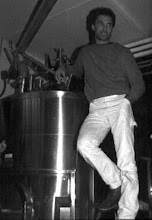All set? No on to my post...
As owner/operator of two small breweries, I also read Beer Advocate to see what people are saying about Smuttynose Brewing & the Portsmouth Brewery. (Kind of like googling yourself, I guess) This morning, I noticed a post about our Big Beer Series release schedule and felt compelled to weigh in, which I don't do very often. Here's the initial post in the thread:
Smuttynose big beer schedule?
So being a big fan of the smuttynose big beer series I was quite excited to see the line up for 2010 line up. And even more excited to see the first beer sceduled for Jan was a barleywine. So here's the question, needless to say were a week plus into february and I have seen no sign of the barleywine. Am I the only one or has this for some reason just not made its way into VT? Any thoughts?
Followed by my lengthy response:
Peter from Smuttynose here, weighing in on a subject that's near and dear to my heart - our Big Beer Series. First of all, let me say how great it makes us at Smuttynose feel to see how highly sought after these beers have become. It doesn't seem that long ago - back in 1998 when we began the series - that we had pallets of the stuff gathering dust in our warehouse, with wholesalers and retailers alike telling us that "Big Beers in Big Bottles" was a really stupid idea. "Why don't you make beers that are more 'drinkable,' like Corona?" we were told. We didn't agree, and, thankfully, beer lovers didn't, either.
But on to the subject at hand. Our Big Beers appear at different times in different markets for a variety of reasons, several of which have been pointed out above. Let me begin by stating that we offer each new Big Beer edition to every market in which we have distribution at the same time; we don't release in one place and hold back in another. I can't think of a good reason why we'd do that, yet we've been accused of it nonetheless. We have altered our release schedule from time to time, sometimes delaying the release of a particular edition because the previous edition is moving more slowly than anticipated and it is backed up in our warehouse. In 2008, during the worst of the hop shortage, we reshuffled our release dates to match the availability of certain hops.
In addition to that, a number of our wholesalers have the maddening practice of only keeping one edition in stock at a time, not even allowing for an overlap. They wait until one edition has been completely depleted before ordering the next one. That means that an entire market, or even a whole state, can be devoid of Farmhouse Ale, for example, because half dozen cases of Maibock are sitting on a distributor's warehouse floor. This can result in our Big Beers drying up throughout an entire market, just because of those half dozen cases.
Most successful independent retailers, and a few chains actually prefer to feature several editions of our Big Beer Series simultaneously, but it's hard to convince some wholesalers, who are terrified of being "stuck" with unsold stock. In fairness, a growing number of wholesalers are getting more comfortable and skillful at managing multiple SKU's of smaller brands. In that regard, they are becoming more like wine distributors (which some of them are) than conventional beer wholesalers, who have traditionally succeeded by moving massive volumes of boxes at a high velocity, with razor-thin margins. Many retailers are evolving their business models to keep up with changes in consumer demand, as well. This "back to the future" model - smaller volume, slower velocity, higher margins - is an interesting alternative to the Big Box retail landscape that's emerged globally over recent decades.
Remember, too, that the chain of communication in the beer business is complex and fragile, involving as it does management, sales and production at the brewery, and management, warehouse operators, sales managers, and street level sales rep's on the wholesale side. At the retail level, the players involved are purchasers & category managers (in the case of chains), and store-level managers. All of these parts rarely make for a well-oiled machine, especially when you're a tiny supplier like Smuttynose. Sometimes our products don't reach the consumer in a timely fashion because of a simple failure of communication somewhere along that chain.
Our home market in New Hampshire is dominated by three large supermarket chains, which impacts that market profoundly, as they tend to focus on nationally advertised brands and have less focus on small, local suppliers. The handful of independent stores do the best they can, but there aren't enough of them to form a critical mass, and the consumer ends up with far fewer choices than in neighboring states. (At Smuttynose, we are beer drinkers as well as brewers, and we lament that fact as much as any of the rest of you!)
It's worth mentioning that as consumers, we are in the driver's seat. In my view, that is the best thing about the Beer Advocates, they (we) are, well, Beer Advocates who have driven massive changes in the beer industry, which is very different today than when I started 23 years ago. And it continues to change. We're not done yet!
OK, I've killed way too many pixels writing this, so I'll call it quits now. Thanks for listening.
Cheers,
P-
